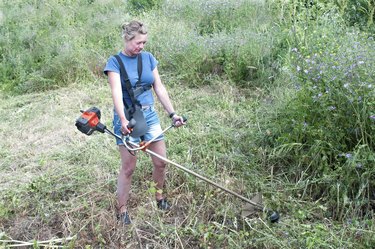
Toro makes corded, cordless and gas-powered string trimmers, and starting problems with electric models can usually be traced to a loose electrical connection or dead battery. Starting problems with gas trimmers aren't as easy to diagnose. All Toro trimmers have two-cycle engines, and assuming you're using the proper fuel-to-oil mixture, which is 50-to-1, hard-starting may be related to improper starting procedure, carburetor problems, a fouled spark plug or dirty filters.
Start 'Er Up
Video of the Day
The procedure for starting a Toro string trimmer is the same one you use for most trimmer models, except that you don't have to worry about the engine stop switch -- it automatically resets to the "On" position. Improper operation of the choke is responsible for many starting problems. To start a cold engine, pump the primer bulb eight times, set the choke to "Full Choke" and pull the cord up to four times while engaging the throttle trigger. If the engine doesn't start, set the choke to "Half Choke" and try six more times. Repeat the procedure once, and if the engine doesn't start, let it sit idle for 10 minutes to allow the carburetor to drain before trying again.
Video of the Day
Check the Spark Plug
If you use the proper starting procedure through several cycles with no success, it's time to perform some maintenance procedures that you should do regularly, but for which you may not have had time. Remove the spark plug boot, unscrew the plug with a socket wrench and examine the terminals. If they are clogged with carbon deposits, it's an indication of incomplete combustion, which could be caused by low-quality fuel or dirty air filters. If the terminals are eroded, on the other hand, it just means the plug is worn. Spark plugs are inexpensive, so either way, it's best to replace it.
Clean the Filters
After replacing the plug, try two simple tests. The first is to loosen the fuel cap and try starting the engine. If it starts, it means the fuel filter and check valve -- which are in the cap -- are fouled or nonfunctioning. Replace the cap. The second test is to loosen the knob holding the air filter cover, remove the cover and the filter, and try the engine. If it starts, it's time to clean the filter with soapy water and then add a few drops of oil, or replace it. A dirty spark arrestor also inhibits air flow, and you should clean the arrestor screen regularly by brushing off soot with a wire brush. The spark arrestor is attached to the muffler. To access it, unscrew the engine cover and muffler, pull the muffler out and pull the screen off the muffler.
Fuel and Carburetor Problems
If the plug and filters are clean and the engine won't start, the problem is related to fuel quality or blockages in the carburetor. You can often ameliorate these by removing the air filter, spraying starting fluid into the air intake and allowing the engine to burn off the bad fuel and varnishes that are creating blockages. When this doesn't work, it's best to drain the fuel tank and replace the fuel, because old fuel collects moisture that prevents ignition. In the extreme, you may have to remove the carburetor and clean it.